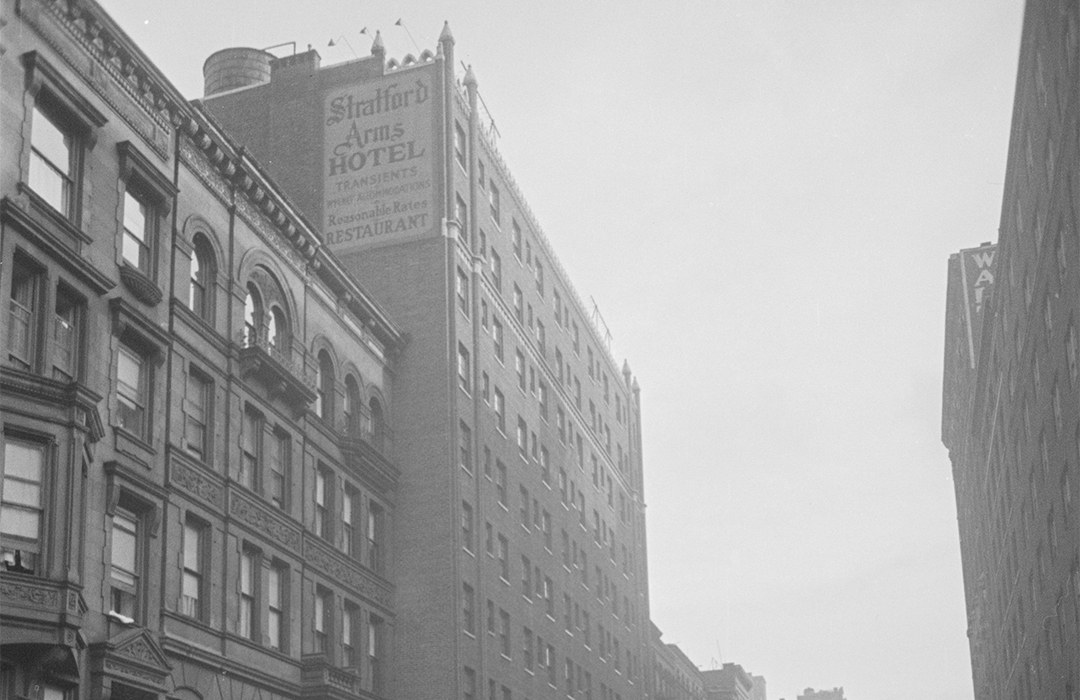
115-123 West 90th Street
by Tom Miller
In 1928, the N. C. H. Security Co. commissioned the architectural firm of C. Howard Crane & Associates to design a residential hotel “with the special object of providing attractive living quarters for young men and women earning modest salaries,” as described by The New York Times. Opened in January 1929, the Stratford Arms filled quickly. According to the mortgager, it was two-thirds rented during construction. In keeping with the decorum of the period, there were separate floors for single women.
The architects placed nine floors of beige brick upon a stone base. A blend of neo-Gothic and neo-Tudor styles, it featured large Gothic-arched shop windows on the ground floor. The entrance was recessed within a gaping terra cotta frame that suggested a portcullis might drop at a moment’s notice. The plaque announcing the building’s name was surmounted by the Prince of Wales, three ostrich feathers and coronet executed in terra cotta.
In February 1934, a 23-year-old Danish man arrived in New York. Years before he would take the title of Baron Timme Rosenkrantz and become a noted author and jazz enthusiast, he wanted to hear authentic jazz for himself. In his book Harlem Adventures, he relates that a fellow passenger on the ship “had recommended a ‘nice little’ family hotel called the Stratford Arms.” He continues:
The Stratford turned out to be a five-hundred-room family hotel. I got a single for a dollar and a half a day. A room with adjoining shower and toilet, nice and clean and more than good enough for me…The shower had to be shared, and visions of something fresh and dainty were not unpleasant. But alas, my neighbor turned out to be a somewhat furtive chap who, to my movie-oriented mind, resembled a Chicago gangster.
The entrance was recessed within a gaping terra cotta frame that suggested a portcullis might drop at a moment’s notice.
Rosenkrantz stunned the counter man when he asked how to get to Harlem. He was intent on hearing live jazz. Rebuffing all suggestions for Midtown hotels where bands could be heard, the young Dane insisted that Harlem was the only spot to hear authentic jazz from the likes of Duke Ellington and Louis Armstrong.
- C. H. Security Co.’s timing was unfortunate in erecting the Stratford Arms. Nine months after its opening, the Stock Market crashed. The building was lost in foreclosure in 1935.
By mid-century the Club Musicale occupied part of the basement. In 1955 Doc Pomus, who also lived in the building, entertained audiences there. The blues singer-songwriter would go on to write songs like Go, Jimmy, Go; Sweets For My Sweet, which was a hit for The Drifters; and Lonely Avenue for Ray Charles. In his Pomus & Shuman, Hitmakers Together & Apart, Graham Vickers notes:
It was at the Stratford that the writing partnership began with Doc offering to give Mortie [Shuman] 10% (or 15%–versions differ) of every song just to sit there and watch how he worked.
The Stratford Arms had started to decline around the time that Pomus performed here. In 1958, rooms were rented at $18 a week, or about $109 by 2024 conversion. On February 28 of that year, Daniel McDonald checked in. He supported himself by gambling and, according to the Staten Island Advance, “won $400 in one day at the Jamaica race track.” As it turned out, however, McDonald was an alias and the gambler’s true name was Emil Maerling.
Four months earlier, in September 1957, the 43-year-old was released from Auburn State Prison after serving two and one-half years for armed robbery. Estranged from his wife, he had gone to live with his sister. Then he learned that she was “keeping company with Michael Ciccarone, 43,” according to the Staten Island Advance.
As Ciccarone was dialing a detective from a phone booth on October 27, hoping to get police protection, Maerling appeared with a gun. He forced Ciccarone into his car and drove to his wife’s house. There, he demanded that Ciccarone stop seeing Mary Maerling. Ciccarone replied that he would, “only if Mrs. Maerling asked him.” At that point, Maerling yelled, “You don’t deserve to live, you rat!” The Staten Island Advance reported, “He fired four bullets into Ciccarone’s body and fled.”
Detectives were almost certain Maerling had not left Manhattan and suspected he was on the Upper West Side. On a tip that he had been seen in the West 70s, they combed the neighborhood with a photograph, asking residents and shop owners if they had seen him. Their persistence paid off when the clerk at the Stratford Arms said, “Sure. That’s Daniel McDonald.”
Undercover police laid in wait in the hallway outside his room. When he walked out and realized he was trapped, he reached for his .32 caliber automatic that was tucked inside his shoulder holster. The police were faster. They grabbed the gun before he could fire and took him away in handcuffs.
Undercover police laid in wait in the hallway outside his room.
Within a decade, the Stratford Arms was operated as a single-room-residency hotel. It was the center of a social experiment starting in 1967. “The Stratford Arms was typical of most S.R.O.’s,” Sheila Gorsky, who was the supervisor for the five caseworkers assigned to the hotel, told The New York Times. “Most of the people who lived there were isolated from each other.” She described the residents as “single welfare recipients who may be outpatients from mental or medical hospitals, between jobs, aged or disabled.”
The city tried out a program, instituting a “sewing club, record player, television, a 1,700-book library” and monthly birthday parties. On June 18, 1967, eleven residents staged “a spirited production of ‘The Fantasticks,’” according to The New York Times.
The program was only partially successful. On April 15, 1987, The New York Times reported that what had been believed to be a model program had flaws. Some disruptive tenants—including a prostitute who worked in her room—“refused to cooperate with efforts to change their lives.”
Then, in April 1996, the city announced, “a social service agency will alter the hotel’s residential mix somewhat, bringing in 25 mentally ill people now living on the streets of the West Side.” The concept, understandably, unnerved many locals.
Those locals were concerned again in 2023 when the Mayor’s Office announced that the Stratford Arms would become a Humanitarian Emergency Response and Relief Center—a shelter for incoming migrants. The HERRC remains in the hotel.
Tom Miller is a social historian and blogger at daytoninmanhattan.blogspot.com


